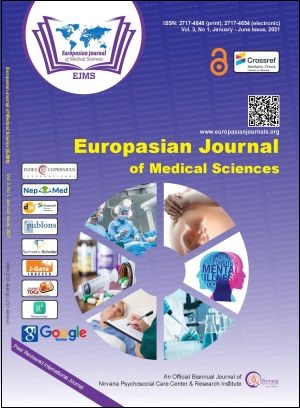Prevalence, Knowledge and Risk Factors for Postpartum Depression in Western Nepal - A Cross-Sectional Study
Keywords:
EPDS, Nepal, Post-partum depression, Postnatal care in Nepal, Depression in NepalAbstract
Background: Postpartum depression(PPD)can be defined as nonpsychotic depression occurring within a year after childbirth, characterized by low mood, unusual thoughts, feeling of guilt, unexplained anxiety, worthlessness, and other depressive symptoms. Objective: This study aims to assess the prevalence, knowledge and risk factors of postpartum disorder.
Methods: A cross-sectional descriptive study was conducted among 217 postpartum mothers in the outpatient department of psychiatry of a tertiary care hospital using the Edinburgh postnatal depression scale(EPDS). All the patients enrolled were directly interviewed using a structured questionnaire to identify the associated risk factors of
postpartum depression. The data collected were checked for validity and analyzed using S.P.S. version 16.0.
Results: Out of 217 patients, five women were found to have an EPDS (Edinburgh postnatal depression scale) score greater than 10. The prevalence of postpartum depression was found to be 2.3%. Upon evaluation of knowledge about postpartum depression, 90.3% of women were found to have a poor level of knowledge and 8.8% had a good knowledge level. The statistically significant factors associated with postpartum depression were the lack of support from family and partners (p<0.005).
Conclusion: There was a comparatively low prevalence of P.P.D. in Western Nepal. Majority of the mothers (90.3%) were found not aware of P.P.D. The present study concluded on the need for educational intervention among the mothers regarding P.P.D. in Western Nepal.
Downloads
Downloads
Published
How to Cite
Issue
Section
License
Copyright (c) 2021 Sapana Karki, Shila Gurung

This work is licensed under a Creative Commons Attribution 4.0 International License.
The author(s) retain the ownership of the copyrights for their work published in EJMS without any restrictions. Upon submission, the author(s) grants EJMS a license to publish, including to display, store, copy, and reuse the published content.
License to Publish
By submitting a manuscript to EJMS, the author(s) grant the journal a non-exclusive license to:
- Publish and distribute the content in all formats, media, and platforms (both existing and future), while identifying EJMS as the original publisher.
- Reproduce, display, and store the content in both print and online formats, including institutional and digital repositories.
- Translate, adapt, and summarize the work, including reprints, extracts, and abstracts.
- Develop derivative works based on the original content.
- Include the work in electronic databases and provide links to third-party materials.
Creative Commons Licensing
In addition to EJMS’s publishing rights, authors grant third parties the right to use, share, and distribute their work under the Creative Commons Attribution 4.0 (CC BY 4.0) International License. This allows unrestricted use of the content, provided proper attribution is given to the original author(s) and the journal.

